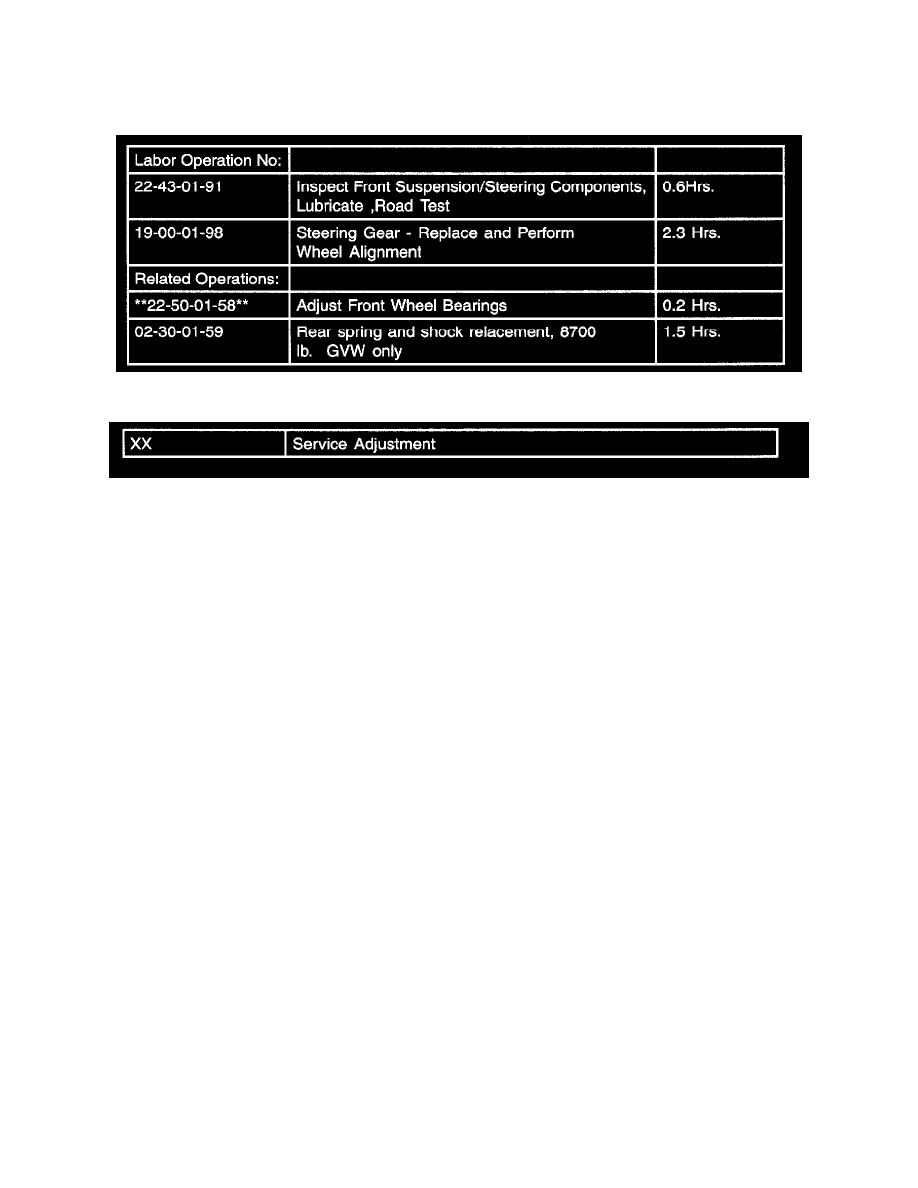RAM 2500 Van V8-5.2L Prop VIN 2 (2000)

PARTS REQUIRED:
POLICY:
Reimbursable within the provisions of the warranty.
TIME ALLOWANCE:
FAILURE CODE:
Diagnosis/Repair Procedures
1.
Verity that the vehicle is not equipped with non-factory installed options, or equipment that may cause the vehicle to wander. Equipment such as
heavy tool boxes or hardware may cause the vehicle to exceed the front or rear Gross Axle Weight Rating (GAWR).
2.
Inspect the front suspension components including wheel bearings, for any signs of wear or damage. Make any repairs necessary.
NOTE:
MOST AIR LEVELING SYSTEMS DESIGNED FOR THE RAM VAN/WAGON SHOULD NOT CAUSE STEERING WANDER. HOWEVER,
THE AIR LEVELING SYSTEM MAY BE INSTALLED ON THE VEHICLE TO ADJUST VEHICLE ATTITUDE. IF THE VEHICLE IS
EQUIPPED WITH AN AIR LEVELING SYSTEM, ENSURE THE SYSTEM IS INFLATED TO THE MANUFACTURERS SPECIFICATIONS
PRIOR TO PROCEEDING.
3.
Lubricate all front steering and suspension system components.
4.
Inspect the condition and size of all tire and wheel assemblies. Tires that are worn or damaged and/or wheels that are of a different size and/or
offset than recommended, may cause the vehicle to wander. Any tires or wheels which exhibit the conditions stated above should be replaced
before continuing with the diagnosis.
5.
Inflate the tires to 65 psi. - front and 80 psi. - rear
NOTE:
-IMPORTANT- TIRE PRESSURES ARE NORMALLY SET TO THE LIGHT LOAD SPECIFICATION WHEN PERFORMING STEERING
WANDER DIAGNOSIS, HOWEVER, HEAVILY LOADED VEHICLES SUCH AS MOTOR HOMES OR CONVERSION VANS, OR
VEHICLES USED FOR SHUTTLE SERVICES WHICH ARE OFTEN FILLED WITH PASSENGERS WILL REQUIRE ADDITIONAL
PRESSURE. HEAVILY LOADED VEHICLES SHOULD BE RUN WITH TIRE PRESSURES OF 65 PSI. - FRONT AND 80 PSI. REAR TO
ENHANCE STEERING PERFORMANCE. THIS INCREASE IN TIRE PRESSURE ALONE MAY BE ALL THAT IS REQUIRED TO
CORRECT THE CONDITION.
6.
Validate the customer's concern by test driving the vehicle on a smooth highway, free of road crown, ruts, speed bumps, or potholes. Drive the
vehicle at speeds between 80 - 113 km/h (50 - 70 mph), preferably without crosswind conditions. If crosswind conditions are prevalent, drive the
vehicle in both directions relative to the crosswind. Return the vehicle to the customer if the steering wander condition has been repaired. If the
vehicle still exhibits a steering wander condition, proceed to the steering gear replacement procedure.
NOTE:
VEHICLES THAT DO NOT EXHIBIT A STEERING WANDER CONDITION DURING THE ROAD TEST MAY HAVE HAD THE
CONDITION CORRECTED WITH STEPS 1-6, OR THE CONDITION MAY HAVE BEEN CAUSED BY ROAD OR WEATHER
CONDITIONS (E.G. WIND, HIGH ROAD CROWN, GROOVED ROADS, ETC.).
